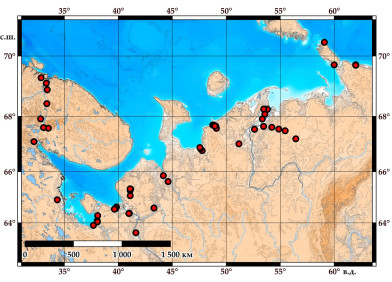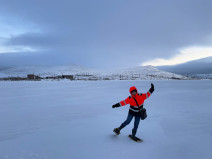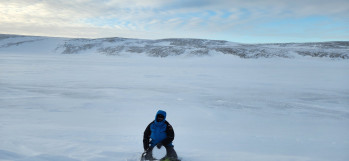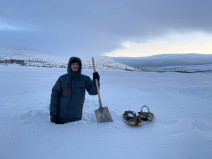 In February-March 2024, employees of the North-Western Branch of the Shirshov Institute of Oceanology of RAS conducted expeditionary studies of the geochemical characteristics of the snow cover in the western sector of the Russian Arctic: on the territory of the Kola Peninsula, the White Sea-Kuloi Plateau, the Nenets Autonomous Okrug, on the coast of the Dvina, Onega, Mezen Bay of the White Sea. Expeditionary work included taking snow samples from selected sites.
In February-March 2024, employees of the North-Western Branch of the Shirshov Institute of Oceanology of RAS conducted expeditionary studies of the geochemical characteristics of the snow cover in the western sector of the Russian Arctic: on the territory of the Kola Peninsula, the White Sea-Kuloi Plateau, the Nenets Autonomous Okrug, on the coast of the Dvina, Onega, Mezen Bay of the White Sea. Expeditionary work included taking snow samples from selected sites.
At the same time, the characteristics of snow accumulation and the main properties of deposited snow were determined. Measurements were made of the height of the snow cover, the volume of selected snow, the structure of the snow mass, the shape and size of grains in the snow mass were described. In the field, measurements of the pH level and mineralization of the thawed phase of the snow cover were carried out. The content of biogenic elements, ionic composition, quantitative characteristics of suspended matter, content of metal forms, material composition and algological composition of the snow cover will be determined in the snow cover.
These studies have been carried out for the second year with the support of the Russian Science Foundation grant No. 22-77-10074 (headed by E.I. Kotova, Ph.D.).
Based on the results of last year, it was established that the snow cover of the estuarine areas of rivers in the south-east of the Barents Sea has a unique composition, which is formed in conditions of close interaction with both the air and water environments. In winter, in addition to the atmospheric transport of sea aerosol, sea water seeping through the ice can enrich the snow cover with salts, thereby increasing mineralization and pH levels.
This effect is most clearly visible in the Indiga River estuary, and a little less at the mouth of the Pesha River. It has been shown that the concentration of suspended particles in snow is minimal in the territory of the Siysky nature reserve and the Pinega nature reserve. Increased concentrations of suspended matter were obtained on the coast of Onega Bay near rock outcrops. In most of the studied points, the pH varied in the range of 5.0–9.2. The snow cover had more alkaline properties in the coastal regions of the Nenets Autonomous Okrug.
The elemental composition of suspended matter in snow is distributed relatively evenly across the studied areas, however, increased contents of V, Co, Ni and Cu were noted in samples taken in the Murmansk region.






